Why are gas prices at record highs? Fact vs. fiction
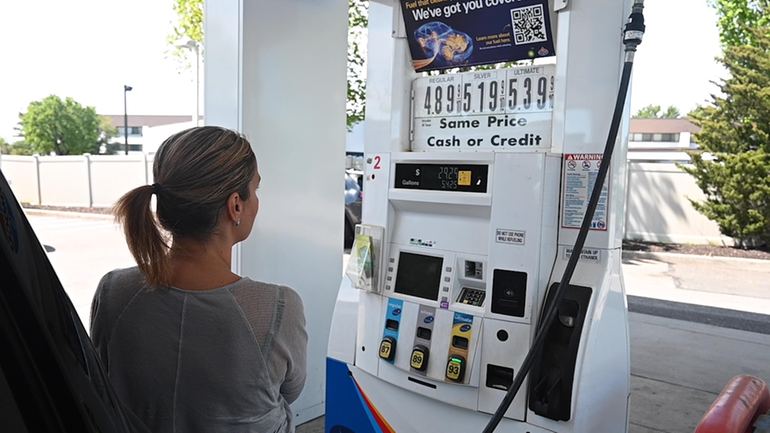
It costs more every day to get behind the wheel.
Gasoline prices on Long Island are poised to hit $5 a gallon, up nearly $2 from a year ago, causing consumers to wonder if there is any end in sight.
Long Island’s average gas price has been rising daily since April 25, and it has been breaking records every day since May 6, according to AAA data.
The average price for a gallon of regular gas on Long Island on Friday was $4.97, which was 62% more than the price a year ago, $3.07.
But misconceptions abound about what’s behind rising prices at the pumps and what it means for consumers.
So, here is a rundown of some of the claims and facts about rising gas prices, including the causes, who is benefiting the most, and what consumers can do to try to conserve fuel.
Claim: When gas stations raise prices every day, they are price gouging.
Fact: New York state defines price gouging as any noticeably unreasonable prices of essential goods and services during a time of crisis, including disruptions caused by world conflicts, such as Russia's Feb. 24 invasion of Ukraine, according to the New York State Attorney General’s Office, which investigates allegations of gas price gouging.
But price gouging isn’t just a bunch of gas stations in an area charging high prices for fuel, said Halimah Elmariah, spokeswoman for the attorney general’s office.
“So, let’s say on one road, gas prices are going up. If all five gas stations are charging the same price, that is not considered price gouging. What would be considered price gouging is if one of those gas stations or maybe a couple of them are noticeably higher than the rest,” she said.
The attorney general’s office's price-gouging probes take into account several factors, including the source of the gas station’s fuel, and the gas station’s rent and operating costs, Elmariah said.
In April, New York Attorney General Letitia James launched an investigation of the gas and oil industries that will probe “the entire supply chain” for fuel in New York, during normal supply periods and times of “disruption,” to probe for potentially illegal price increases, Newsday reported.
The attorney general’s office does not disclose the number of consumer complaints about alleged price gouging that it receives or which gas stations are being investigated, Elmariah said.
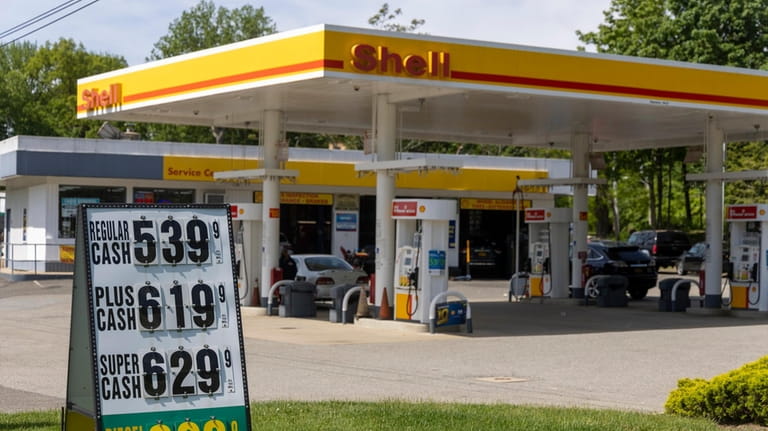
Gas stations' profit margins on gas sales are actually declining, experts say. Credit: Howard Schnapp
Claim: Gas stations are benefiting the most from the rising prices.
Fact: The biggest beneficiaries of rising gas prices are the oil producers and refineries, not the gas stations, energy industry experts said.
The profit margins on fuel sales at gas stations are declining, which is why gas station operators make more profit selling food, lottery tickets, cigarettes and other items inside convenience stores, the experts said.
The average gross profit margins on fuel sold at gas stations as of 6 p.m. Thursday was 41.1 cents a gallon in Suffolk County, compared to 42.8 cents per gallon a year earlier, according to the Oil Price Information Service in Rockville, Maryland. The gross profit margin was 43 cents per gallon in Nassau County on Thursday, compared to 41.8 cents per gallon a year earlier.
Those numbers don't factor in credit/debit card fees or freight costs, the latter of which has risen considerably over the last few years due to truck driver shortages and increasing fuel costs, said Brian Norris, executive director of retail data and product management at Oil Price Information Service.
"If you factor in those, it’s likely that net margins in Suffolk/Nassau counties are actually lower than last year ... [Net margins are] higher than pre-pandemic levels for sure, but [sales] volumes are still depressed significantly from where they were in 2019," he said.
Meanwhile, oil producers and refineries have seen profits soar this year.
Large players, such as ExxonMobil, Chevron and Shell, all produce and refine oil.
ExxonMobil, the biggest U.S. oil company, saw its earnings more than double to $5.5 billion in the first quarter of this year compared to the same period last year, even after the Irving, Texas-based company took a $3.4 billion charge due to discontinuing its operations in Russia because of the war in Ukraine.
Chevron’s first-quarter profit was $6.3 billion, which was quadruple the amount from the same period last year, according to the San Ramon, California-based company.
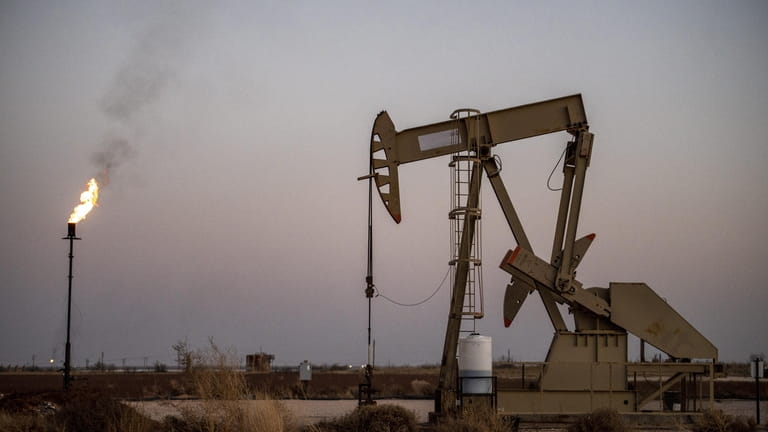
Big oil producers and refiners, like ExxonMobil, are the players making the most profit off higher prices. Credit: Bloomberg/Sergio Flores
Claim: New York state's high taxes are behind the big fuel costs.
Fact: Drivers in New York state were paying the ninth-highest fuel taxes, an average of 66.62 cents per gallon in local, state and federal taxes, in the nation as of Jan. 1, according to the American Petroleum Institute, a Washington, D.C.-based trade association for the oil and natural gas industry.
When gas prices hit $5 per gallon, state taxes on fuel rise to about 54 cents.
Some tax relief legislation was enacted recently.
In April, Gov. Kathy Hochul signed fuel sales tax relief, as part of the state fiscal year 2023 budget.
The state’s sales tax on motor fuels was partially suspended, for 16 cents off the 33.35 cents of state sales tax per gallon of fuel, from June through December.
Also, the State Legislature gave counties the option of capping sales taxes on fuel at $2, $3 or $4 per gallon.
In April, Suffolk and Nassau counties’ legislatures approved partial tax caps on fuel purchases, with the first $3 per gallon of gas being taxed at the 4.25% county sales tax rate, but the remaining cost not being taxed.
“At today’s prices (roughly $5 per gallon), we estimate that the county legislation would save the average consumer approximately 9 cents per gallon, in addition to any savings from the state tax changes,” said Christopher Boyle, spokesman for Nassau County.
Nassau County’s cap will go into effect June 1, or earlier if the state allows, and it will expire Dec. 31.
Suffolk County’s cap will go into effect June 1 and will expire Dec. 1.
Claim: If President Joe Biden hadn’t canceled the Keystone XL pipeline project, gas prices would be lower.
Fact: A Canadian company, TC Energy, was the sponsor of the Keystone XL pipeline project, which was to be a 1,200-mile pipeline that would have transported 830,000 barrels of crude oil daily from western Canada to Nebraska, Montana and South Dakota. Initially proposed in 2008, construction stalled for years over opposition from environmentalists and Native American tribes along its route.
Former U.S. President Donald Trump approved a permit for the line in 2017, but the continuing legal challenges delayed construction.
In January 2021, Biden canceled a key permit for the pipeline over environmental concerns, and TC Energy abandoned the project in June 2021.
But the pipeline wouldn’t have made much, if any, difference in gas prices, several energy experts said.
“It could have had an impact on what we pay for gasoline in the second half of the decade but it wasn’t going to be bringing more Canadian oil to the U.S. in the first few years of the Biden administration. So, that’s a bum rap but it’s one that gets a lot of play in the false narrative,” said Tom Kloza, global head of energy analysis at the Oil Price Information Service.
The amount of crude oil that would have been brought to the United States with the Keystone XL pipeline would have been inconsequential, given the amount of crude that U.S. consumers use — about 20 million barrels daily — and that the United States produces — 11 million barrels daily, said Chris Lafakis, director of energy and climate economics at Moody’s Analytics in West Chester, Pennsylvania.
The bigger question is why U.S. oil producers aren’t drilling more when they have a clear financial incentive to do so, given current high crude oil prices, he said.
“That pipeline has no influence whatsoever on U.S. oil drillers’ decision to drill or not, where to drill, how much to drill, how much they would invest in,” Lafakis said.
But drillers have uncertainty about how long prices will remain elevated because of the war in Ukraine, so they worry they could find themselves overextended once the conflict ends, he said.
Furthermore, the pipeline won’t repair the economic damage caused by the COVID-19 pandemic, which led to oil companies laying off thousands of workers due to consumer demand for fuel declining in 2020 and 2021, said Patrick De Haan, head of petroleum analysis at GasBuddy, a Boston-based technology company that provides fuel price data.
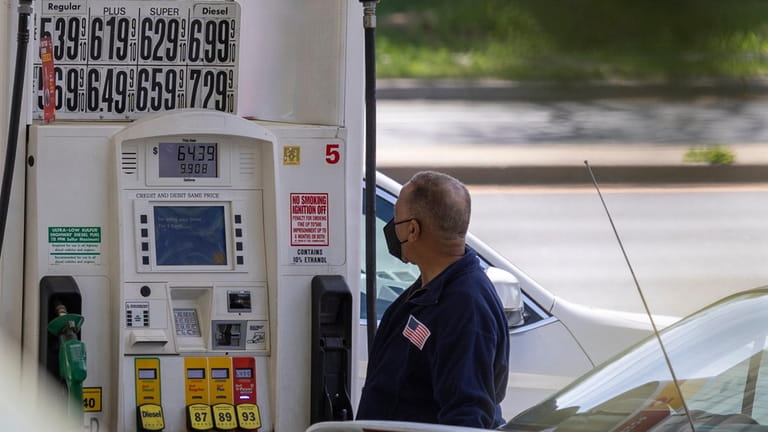
Gas prices at a Shell station on Jericho Turnpike in Jericho on Wednesday. Credit: Howard Schnapp
Claim: The price of crude oil can’t be affecting the price of gas as much as some say it is.
Fact: Crude oil is refined to produce gasoline, diesel and other types of fuel. The rising price of crude can be best described as a matter of low supply and increasing demand, which means higher costs, according to energy industry experts.
The biggest factor in the rising price of gas is the price of crude, which accounted for 53.6% of the average retail gas price in 2021, according to the U.S. Energy Information Administration.
Another factor in rising gas prices is the increasing cost to refine crude oil into motor fuel.
Crude is traded globally, so its price is determined by a global market.
And the price of crude has risen significantly this year because of Russia’s invasion of Ukraine, according to experts.
Russia is the third-largest producer of oil and other petroleum liquids in the world, according to the U.S. Energy Information Administration. The country produced 10.78 million barrels a day in 2021, and that accounted for 11% of the world's total, according to the agency.
Russia also was the second-largest oil exporter last year, exporting 7.5 million barrels daily, and half of that went to Europe.
But with a growing number of countries, including the United States, banning Russian oil imports, and "self-sanctioning" refineries and energy traders no longer buying from Russia because of the war, Europe is “desperately short of hydrocarbons, whether it be natural gas, crude oil, gasoline or diesel,” Kloza said.
The amount of Russian oil taken off the market is projected to reach 3 million barrels a day in May and June, and that amount would rise to an estimated 4 million barrels a day if the European Union bans Russian imports as it has threatened to do, Lafakis said.
So, Russia's former customers have to find other sources of crude, whose inventories are already low because production was down amid the pandemic, experts said. And there is uncertainty in the global market over the war, they said.
“It doesn’t take much to sort of upset the apple cart," Kloza said.
The price of benchmark U.S. crude oil Thursday settled at $112.21, which was 21% higher than the price three months ago and nearly 74% more than the price a year ago.
Meanwhile, as businesses have reopened after months of shutdowns during the COVID-19 pandemic, consumer demand for gas is up as people return to driving for work and leisure, while crude oil production has not returned to pre-pandemic levels.
“As the economy opened up in late 2020-2021, demand for petroleum products increased faster than production. When that happens, you have to draw out of inventories in order to satisfy demand. Even though production is on the way up, it hasn’t yet caught up with demand, so that’s why supplies remain low,” said Chris Higginbotham, spokesman for the Energy Information Administration.
Claim: Turning off your car’s air conditioner will save gas but keeping the windows open will make the car drag, burning more fuel.
Fact: Turning off the AC and rolling the windows down to let in fresh air can feel great but it won’t make much difference in fuel savings, said Ronald Montoya, senior consumer advice editor for Edmunds, a Santa Monica, California-based auto retail information company. Edmunds studied vehicles with windows down and AC off, and windows up and AC on, and found no measurable difference in fuel economy and no difference in drag, he said.
“It’s going to vary by vehicle but for the most part, it should be the same thing,” he said.
What the study did find, however, was that not all sources of fresh air are the same, Montoya said.
Having the sunroof open will create more drag because of the direction of the air, so the car has to work harder — and burn more fuel — to maintain speed, he said.
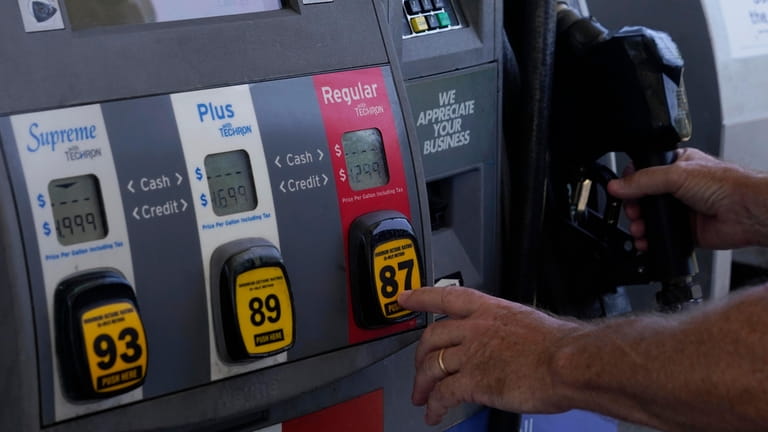
Buying premium gas won't increase fuel efficiency, and regular shouldn't hurt your engine even if the manufacturer recommends premium, an expert says. Credit: AP/Marta Lavandier
Claim: Premium gas provides better fuel efficiency for cars.
Fact: In most newer-model cars in which premium gas is not required, there is no measurable difference in fuel efficiency, Montoya said.
“So, you’re basically wasting your money, especially these days when premium is so expensive,” he said. On Friday, the average price for a gallon of premium was $5.50, according to AAA.
In cases in which premium gas is recommended by the car’s manufacturer, but not required, the car might not have as much power if regular gas is used, which means the automobile “might feel a touch slower. But in terms of harming the vehicle long term, it shouldn’t impact it,” he said.
With Yancey Roy

